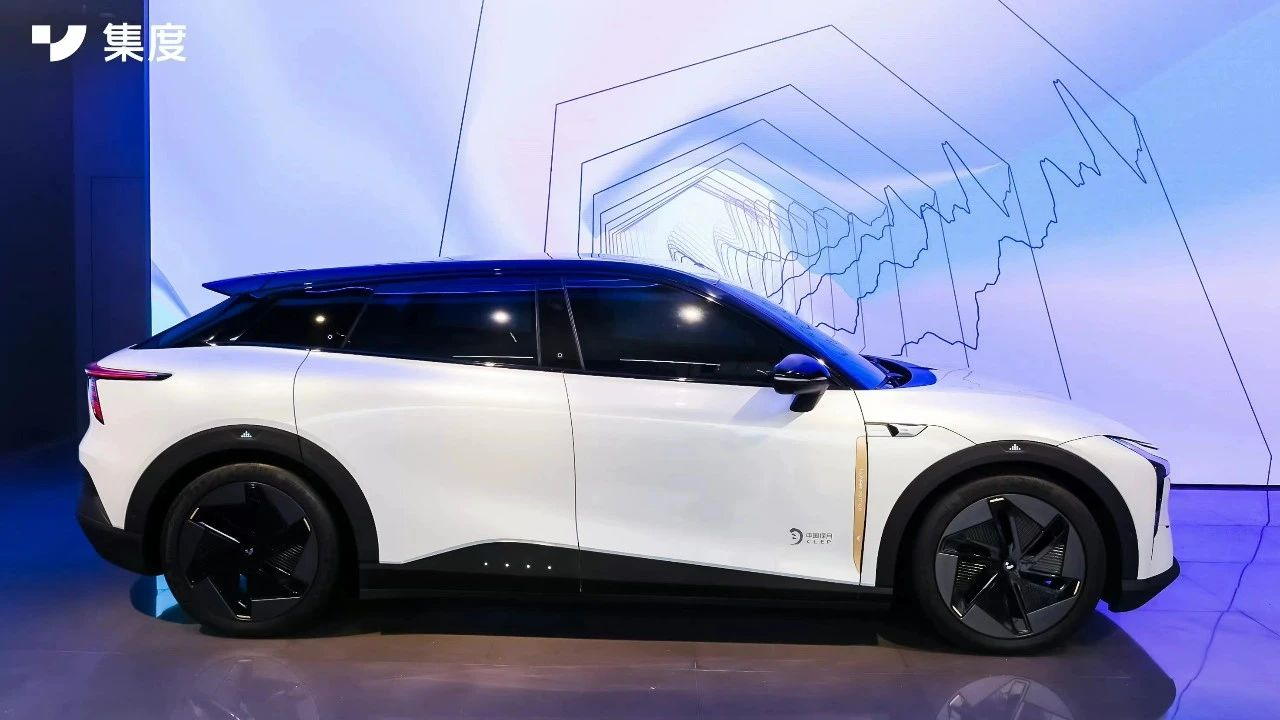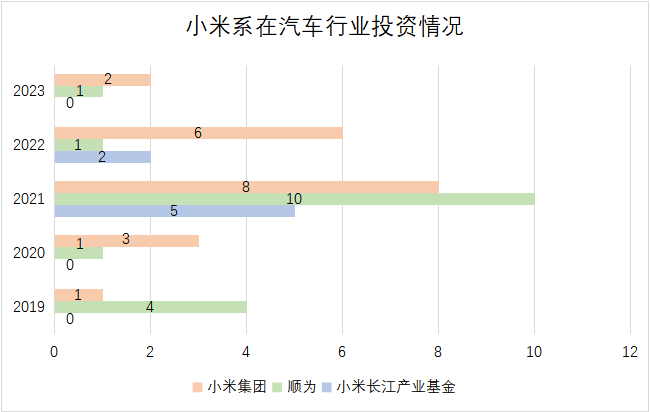Characteristics of Tide in the Automotive Industry
Written by Wu Xianzhi
Edited by Wang Pan
The characteristic of tide is “wave”, which is even more severe in the automotive industry.
In January of this year, the auto market was dull. Despite the previous leaders such as BYD, Geely, Great Wall, and the previous latecomer, WmAuto Xaoli, except for DENZA, all experienced a significant decline in growth rate compared with the previous period. At the turning point of the industry, the car companies that had not yet delivered successfully attracted attention from the outside world.
Due to the disclosure of mold information by suppliers, Xiaomi was busy punishing its suppliers. The result of Lei Jun’s “zero tolerance” was a 1 million yuan economic compensation and punishment of personnel involved, without affecting the cooperative relationship. A well-informed source told Photon Planet that with the help of Beiqi and FAW, Xiaomi has weak bargaining power in the supply chain.
A Xiaomi auto supplier confirmed to us that “we have been cooperating with Beiqi and FAW for many years, and without their mediation, it is difficult to contact Xiaomi.” This supplier has also signed a confidentiality agreement with Xiaomi. In fact, after selecting suppliers last year, some manufacturers have received demand from Xiaomi one after another, and some even made samples.
Judging by progress, Jidu’s team was set up earlier and has made faster progress than Xiaomi. When Lei Jun was visiting supply chain companies in 2021, Jidu had already entered the trial production stage.
Recently, this newly rising force, which has received care from Robin Li, has many topics, from the opening of the Sanlitun experience store to stepping on ChatGPT, to announcing Baidu Wenyi Yiyan’s entry into the car, and in short, there are not many topics about cars themselves. During the blank period before ROBO-01 is delivered in the fourth quarter of this year, Jidu obviously hopes to fill more marketing methods to maintain market attention.
At present, WmAuto Xaoli has experienced problems that BYD has experienced in the past, while Jidu and Xiaomi cannot bypass them.
Same Genes, Different Destiny
On March 30, 2021, Lei Jun announced the production of cars, and Xiaomi has since been silent about the matter.
During the days when Lei Jun reviewed and published articles on the public account, Xia Yiping’s team had just rented an office in Shanghai WeWork. At first, when walking past from the outside, everything was clearly visible through the glass wall, and there was no secret at all. In the end, they had to stick a circle of film on the wall to solve the problem. It was not until then that Jidu began to slowly accelerate from brand definition to product design.
 During that period, Jidu was at a crossroads in the early stages of car manufacturing. Writing PPT carefully would accelerate the next step, such as opening the oil mud mold. Jia, the boss who was supposed to go back to China “next week,” was featured in the PPT.
During that period, Jidu was at a crossroads in the early stages of car manufacturing. Writing PPT carefully would accelerate the next step, such as opening the oil mud mold. Jia, the boss who was supposed to go back to China “next week,” was featured in the PPT.
Photon Planet learned that Jidu’s design director, Wu Fan, worked from 9 a.m. to 5 p.m. and continued to write PPT at home in the evening. The 280-plus page PPT included five proposals per page, totaling more than 1,000. Until May 30th, when Li Yanhong saw it in Beijing, most of the 1,000 proposals were scrapped, and only 60 were retained in the end.
After the initial proposals were determined, the car manufacturing had just begun. In the following two months, Jidu opened the oil mud mold. Li Yanhong flew to Shanghai on July 8th to inspect the progress and finally decided on the design plan. The design finalization meant that the long period of wrangling would follow, as the design would be revised continuously during testing.
Design is like clothing, while trial production is like patching. Some patches are too few and look awkward, while some patches are excessive, resulting in wearing a patched-up piece.
During this wrangling phase, the design should remain true to its original intention, the testing engineers should remain loyal to the data, the cost engineers should focus on the cost, and the procurement team should worry about finding suitable suppliers. The advantage is that noise in the workshop indicates that Jidu is truly involved in the car manufacturing process.
During the period when Jidu completed the above process, Xiaomi also made frequent moves. To solve the problem of autonomous driving suppliers, Xiaomi started to recruit intelligent driving talents and invested 77.37 million yuan to acquire Deepmotion Technology. However, it was not until September 1st that Xiaomi disclosed a set of photos to the public, revealing who the core executives of Xiaomi’s car-making business were. In other words, 150 days after announcing car manufacturing, Xiaomi’s car-making team was finally formed.
The two car manufacturers are at odds, and the supply chain is eyeing Xiaomi’s eagerness to make cars. The research and development director of a tier-1 subsidiary under FAW told Photon Planet that Lei Jun said he wanted to invest 10 billion US dollars in car manufacturing, and the entire industry chain is calculating how much they should get. He gave an example to describe the reaction of the auto industry at that time: “In general, no mold development fee is required for large-scale production. After the fierce statement, not charging the mold development fee is somewhat disrespectful to Mr. Lei.”
Objectively speaking, Xiaomi itself faces many difficulties in making cars. Just building a car supply chain requires a lot of effort, while once Jidu comes up with a plan, the rest can be handed over to Li, the boss of Geely.
Due to the vast SEA platform and the cooperation between Baidu and Geely, Jidu has never lacked suppliers since its inception. The factory that produces ROBO-01 is actually the factory that produces Polestar – the new energy brand after Geely and Volvo “grafted”. Although the underlying supply chain claims to be German, a group of suppliers such as Grammer and Dongjian, which provide the cabin and interior, are actually reused from Geely.
Therefore, from a product perspective, the hardware capabilities of Jidu ROBO-01 and ROBO-02 symbolize Geely’s sincerity and strength.
The Second Piece “Bamboo Forest”
Jidu and Xiaomi are like transfer students in the second half of the sixth grade. Time waits for no one, especially in the eyes of suppliers. Xiaomi is a cow that needs to be squeezed no matter what.
Various signs indicate that Xiaomi’s car-making has similarities to building a smartphone supply chain ecosystem. The relevant companies are either small-scale and strongly demand startups. Xiaomi’s car-making can provide them with a comprehensive improvement, including the necessary funds for scaling, brand endorsements, and long-term operations.
A Xiaomi automotive supplier mentioned that during the previous contact, the Xiaomi side roughly introduced the form of cooperation and mentioned the possibility of investment. If a sample can be given within the year, and everything is successful through testing, it will be like water flows and everything falls into place.
This supplier said that “of course, we hope we can get close to such a giant. If they want to invest in us, we might not have the power to say yes or no.” In order not to lose control over the team too early, he has been busy recently, planning to introduce strategic investors.
Another mature case is WeRide. In the $300 million D-round investment in 2021, Xiaomi Group only appeared, and in the subsequent D+ round, the Xiaomi Group added another $70 million alone. As intelligence accelerates, various manufacturers have started to pile up. As a senior player in the piling field, Xiaomi has initially laid out an automotive supply chain ecosystem.
In 2019, Xiaomi Group, Shunwei Capital, and Xiaomi Changjiang Industry Fund began to lay out in the new energy track, and reached its peak in 2021. In that year, the Xiaomi system capital participated in at least 23 companies.
This not only includes the laser radar manufacturer WeRide mentioned earlier but also visual perception chip manufacturers Heizhima Intelligence, AI charging solution provider Shitu Technology, self-driving startup Momenta, and car-mounted HUD (head-up display system) R&D company Zejing Electronics, etc. It is easy to see that a considerable proportion of them are hardware startups.
The competition in new energy vehicles is not just about product competitiveness on the surface, but actually about the competition of supply chain capabilities. In the past, part of BBA’s advantage came from the supply chain. Nowadays, the reshuffle of automotive components has formed individual industrial clusters, such as Horizon and Hesai Technology, which not only have product interoperability, but also have internal management in a coordinated manner.
From chips to cameras, and then to cabins, Xiaomi, which is continuously investing, has accumulated a lot in some core areas. Traditional automotive component suppliers usually face unstable gross profit margins, but Xiaomi’s arrival has brought hope. Will said, “Traditional car companies will take one to two years to process a new design, while new manufacturers will take much less time.”
Will said in a previous small-scale communication meeting that there is a huge difference in process management between new car manufacturing and traditional car companies.
Under the system of reporting from the bottom up, innovation is difficult to grow from the grassroots in traditional car companies, but in Internet companies, there is no such system. Xia Yiping can run into the workshop on weekends to ask questions, and an intern can catch any designer for a brainstorming session.
Many traditional car companies generally have three-level reviews, and most technological innovations disappear in the process.
At the first-level review, the engineering research and development, quality inspection, and cost procurement departments may easily reach a consensus, but at the second-level review, they will face brand, market, marketing, general manager and other links. The battle between different responsible personnel is actually a matter of perspective.
It is understood that traditional car companies are often interconnected and may take about nine months to complete a full set of processes, while new car companies generally adopt parallel processing, which only takes one to three months.
In the Industry, there is a hidden wave of competition
The industry generally believes that when Jidu and Xiaomi enter the market, there is no room for a hidden wave in the industry.
Under the requirements of automobile regulations, it is impossible for Xiaomi and Jidu to give too much advance notice, and it is difficult to make differentiation in limited space. At present, Jidu hopes to avoid becoming the next “self-driving family” among the many, so it frequently associates with “Three-Body”, ChatGPT, and robots. The purpose is to give itself a thick layer of “technology” makeup.

Various explicit and implicit messages conveyed by Xiaomi’s car-making project indicate that there is limited room for the new car to perform. Autonomous driving, complying with regulatory requirements, can only be applied to various scenarios around L2. Following the logic of past “Xiaomi-style” innovations, it is more likely to bring something fresh in industrial design and material science.
For example, introducing new materials for the shell, replacing plastic parts in the interior, and so on. After all, having spent so much money investing in core component manufacturers, there is no need to reinvent the wheel.
To evaluate the partnerships between Jidu and Xiaomi, we need to examine them from three angles: original brand intentions, design landing, and mass production delivery. Jidu always sticks to the futuristic feeling without compromise in design. The following delivery will provide an answer for the market.
As for Xiaomi, after experiencing top-level changes, it now faces many variable factors, such as nurturing supplier relationships and qualifying for car making. However, since they entered the market at such a late stage, they have already left little room to maneuver. They will be overjoyed if they succeed, but in the event of failure, the consequences will be different.
For Jidu, if they fail, besides the loss of initial investment, it should not affect Baidu’s fundamentals. However, for Xiaomi, success or failure in car-making will determine its future. If it fails, it could potentially drag down its mobile business fundamentals.
This article is a translation by ChatGPT of a Chinese report from 42HOW. If you have any questions about it, please email bd@42how.com.
